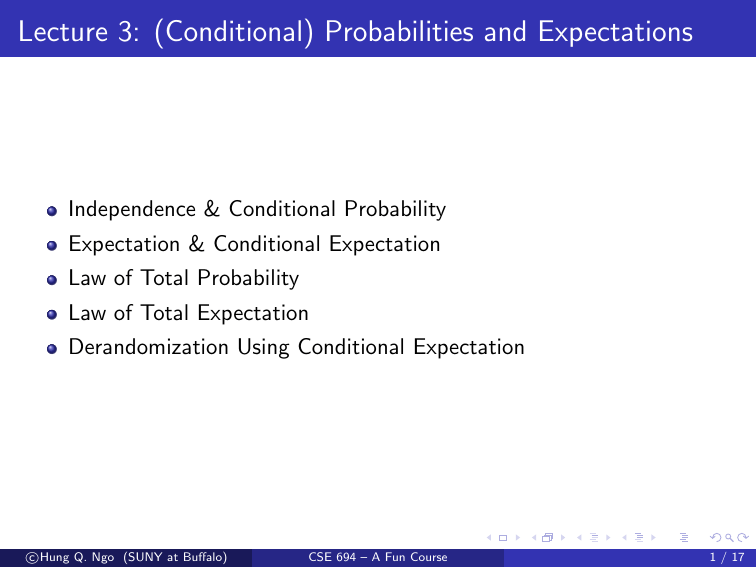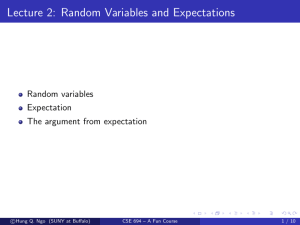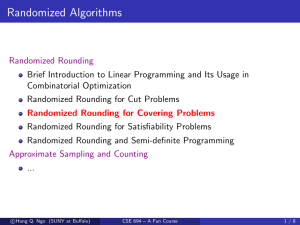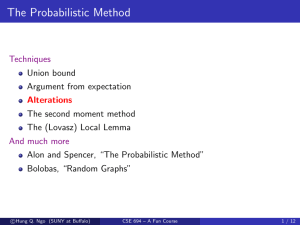Lecture 3: (Conditional) Probabilities and Expectations
advertisement

Lecture 3: (Conditional) Probabilities and Expectations
Independence & Conditional Probability
Expectation & Conditional Expectation
Law of Total Probability
Law of Total Expectation
Derandomization Using Conditional Expectation
c
Hung
Q. Ngo (SUNY at Buffalo)
CSE 694 – A Fun Course
1 / 17
PTCF: Independence Events and Conditional Probabilities
B
A
A∩B
The conditional probability of A given B is
Prob[A | B] :=
Prob[A ∩ B]
Prob[B]
A and B are independent if and only if Prob[A | B] = Prob[A]
Equivalently, A and B are independent if and only if
Prob[A ∩ B] = Prob[A] · Prob[B]
c
Hung
Q. Ngo (SUNY at Buffalo)
CSE 694 – A Fun Course
2 / 17
PTCF: Law of Total Probabilities
Let A1 , A2 , . . . be any partition of Ω, then
X
Prob[A] =
Prob[A | Ai ] Prob[Ai ]
i≥1
(Strictly speaking, we also need “and each Ai is measurable,” but
that always holds for finite Ω.)
c
Hung
Q. Ngo (SUNY at Buffalo)
CSE 694 – A Fun Course
3 / 17
PTCF: Mutually Independence and Independent Trials
A set A1 , . . . , An of events are said to be independent or mutually
independent if and only if, for any k ≤ n and {i1 , . . . , ik } ⊆ [n] we
have
Prob[Ai1 ∩ · · · ∩ Aik ] = Prob[Ai1 ] · · · Prob[Aik ].
If n independent experiments (or trials) are performed in a row, with
the ith being “successful” with probability pi , then
Prob[all experiments are successful] = p1 · · · pn .
(Question: what is the sample space?)
c
Hung
Q. Ngo (SUNY at Buffalo)
CSE 694 – A Fun Course
4 / 17
Example 1: Randomized Min-Cut
Min-Cut Problem
Given a multigraph G, find a cut with minimum size.
Randomized Min-Cut(G)
1: for i = 1 to n − 2 do
2:
Pick an edge ei in G uniformly at random
3:
Contract two end points of ei (remove loops)
4: end for
5: // At this point, two vertices u, v left
6: Output all remaining edges between u and v
c
Hung
Q. Ngo (SUNY at Buffalo)
CSE 694 – A Fun Course
5 / 17
Analysis
Let C be a minimum cut, k = |C|
If no edge in C is chosen by the algorithm, then C will be returned in
the end, and vice versa
For i = 1..n − 2, let Ai be the event that ei ∈
/ C and Bi be the event
that {e1 , . . . , ei } ∩ C = ∅
Prob[C is returned]
= Prob[Bn−2 ]
= Prob[An−2 ∩ Bn−3 ]
= Prob[An−2 | Bn−3 ] Prob[Bn−3 ]
= ...
= Prob[An−2 | Bn−3 ] Prob[An−3 | Bn−4 ] · · · Prob[A2 | B1 ] Prob[B1 ]
c
Hung
Q. Ngo (SUNY at Buffalo)
CSE 694 – A Fun Course
6 / 17
Analysis
At step 1, G has min-degree ≥ k, hence ≥ kn/2 edges
Thus,
k
2
Prob[B1 ] = Prob[A1 ] ≥ 1 −
=1−
kn/2
n
At step 2, the min cut is still at least k, hence ≥ k(n − 1)/2 edges.
Thus, similar to step 1
Prob[A2 | B1 ] ≥ 1 −
2
n−1
In general,
Prob[Aj | Bj−1 ] ≥ 1 −
2
n−j+1
Consequently,
Prob[C is returned] ≥
n−2
Y
i=1
c
Hung
Q. Ngo (SUNY at Buffalo)
2
1−
n−i+1
CSE 694 – A Fun Course
=
2
n(n − 1)
7 / 17
How to Reduce the Failure Probability
The basic algorithm has failure probability at most 1 −
2
n(n−1)
How do we lower it?
Run the algorithm multiple times, say m · n(n − 1)/2 times, return
the smallest cut found
The failure probability is at most
c
Hung
Q. Ngo (SUNY at Buffalo)
2
1−
n(n − 1)
m·n(n−1)/2
CSE 694 – A Fun Course
<
1
.
em
8 / 17
Example 2: Randomized Quicksort
Randomized-Quicksort(A)
1: n ← length(A)
2: if n = 1 then
3:
Return A
4: else
5:
Pick i ∈ {1, . . . , n} uniformly at random, A[i] is called the pivot
6:
L ← elements ≤ A[i]
7:
R ← elements > A[i]
8:
// the above takes one pass through A
9:
L ← Randomized-Quicksort(L)
10:
R ← Randomized-Quicksort(R)
11:
Return L · A[i] · R
12: end if
c
Hung
Q. Ngo (SUNY at Buffalo)
CSE 694 – A Fun Course
9 / 17
Analysis of Randomized Quicksort (0)
The running time is proportional to the number of comparisons
Let b1 ≤ b2 ≤ · · · ≤ bn be A sorted non-decreasingly
For each i < j, let Xij be the indicator random variable indicating if
bi was ever compared with bj
The expected number of comparisons is
X
X
X
Xij =
E[Xij ] =
Prob[bi & bj were compared]
E
i<j
i<j
i<j
bi was compared with bj if and only if either bi or bj was chosen as a
pivot before any other in the set {bi , bi+1 , . . . , bj }. They have equal
chance of being pivot first. Hence,
2
Prob[bi & bj were compared] = j−i+1
Thus, the expected running time is Θ(n lg n)
c
Hung
Q. Ngo (SUNY at Buffalo)
CSE 694 – A Fun Course
10 / 17
Analysis of Randomized Quicksort (1)
Uncomfortable? What is the sample space?
Build a binary tree T , pivot is root, recursively build the left branch
with L and right branch with R
This process yields a random tree T built in n steps, t’th step picks
tth pivot, pre-order traversal
Collection T of all such trees is the sample space
bi & bj compared iff one is an ancestor of the other in the tree T
For simplicity, assume b1 < · · · < bn .
Define I = {bi , bi+1 , · · · , bj }
At = event that first member of I picked as a pivot at step t
c
Hung
Q. Ngo (SUNY at Buffalo)
CSE 694 – A Fun Course
11 / 17
Analysis of Randomized Quicksort (2)
From law of total probability
X
Prob[bi first pivot of I] =
Prob[bi first pivot of I | At ] Prob[At ]
t
At step t, all of I must belong to L or R of some subtree, say I ⊂ L
At step t, each member of L chosen with equal probability
Hence, each member of I chosen with equal probability
Hence, conditioned on At , bi chosen with probability
1
1
=
.
|I|
j−i+1
c
Hung
Q. Ngo (SUNY at Buffalo)
CSE 694 – A Fun Course
12 / 17
Las Vegas and Monte Carlo Algorithms
Las Vegas Algorithm
A randomized algorithm which always gives the correct solution is called a
Las Vegas algorithm.
Its running time is a random variable.
Monte Carlo Algorithm
A randomized algorithm which may give incorrect answers (with certain
probability) is called a Monte Carlo algorithm.
Its running time may or may not be a random variable.
c
Hung
Q. Ngo (SUNY at Buffalo)
CSE 694 – A Fun Course
13 / 17
Example 3: Max-E3SAT
An E3-CNF formula is a CNF formula ϕ in which each clause has
exactly 3 literals. E.g.,
ϕ = (x1 ∨ x̄2 ∨ x4 ) ∧ (x1 ∨ x3 ∨ x̄4 ) ∧ (x̄2 ∨ x̄3 ∨ x4 )
|
{z
} |
{z
} |
{z
}
Clause 1
Clause 2
Clause 3
Max-E3SAT Problem: given an E3-CNF formula ϕ, find a truth
assignment satisfying as many clauses as possible
A Randomized Approximation Algorithm for Max-E3SAT
Assign each variable to true/false with probability 1/2
c
Hung
Q. Ngo (SUNY at Buffalo)
CSE 694 – A Fun Course
14 / 17
Analyzing the Randomized Approximation Algorithm
Let XC be the random variable indicating if clause C is satisfied
Then, Prob[XC = 1] = 7/8
Let Sϕ be the number of satisfied clauses. Then,
"
#
X
X
opt
E[Sϕ ] = E
XC =
E[XC ] = 7m/8 ≥
8/7
C
C
(m is the number of clauses)
So this is a randomized approximation algorithm with ratio 8/7
c
Hung
Q. Ngo (SUNY at Buffalo)
CSE 694 – A Fun Course
15 / 17
Derandomization with Conditional Expectation Method
Derandomization is to turn a randomized algorithm into a
deterministic algorithm
By conditional expectation
1
1
E[Sϕ ] = E[Sϕ | x1 = true] + E[Sϕ | x1 = false]
2
2
Both E[Sϕ | x1 = true] and E[Sϕ | x1 = false] can be computed
in polynomial time
Suppose E[Sϕ | x1 = true] ≥ E[Sϕ | x1 = false], then
E[Sϕ | x1 = true] ≥ E[Sϕ ] ≥ 7m/8
Set x1 =true, let ϕ0 be ϕ with c clauses containing x1 removed, and
all instances of x1 , x̄1 removed.
Recursively find value for x2
c
Hung
Q. Ngo (SUNY at Buffalo)
CSE 694 – A Fun Course
16 / 17








